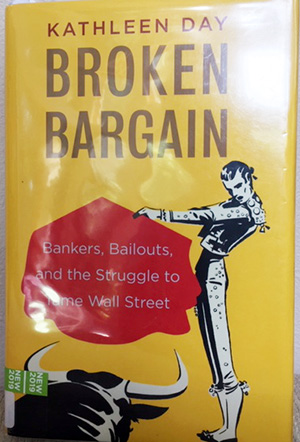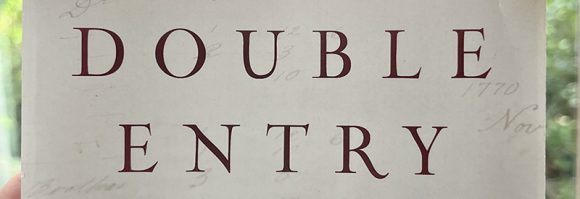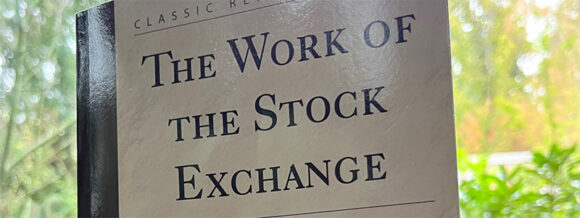
American banks fail when unregulated, and they fail when improperly regulated. That is the one sentence summary of Broken Bargain by Kathleen Day, the latest book in my series trying to understand how the financial system is failing.
My key learnings from his book are highly unlikely what the author intended. She’s a bit too anti-bank for my taste. We’d seem to agree on 99% of what is wrong with the banking system, but for me the problem isn’t poor regulation, it’s a poorly designed system that needs regulation to function. What’s interesting is that she touches briefly on the leverage points to make the structural changes, but too briefly without noticing they exist.
Broken Bargain begins with Hamilton and the first Bank of the United States. This is the reference that sent me down the goose chase which ended up talking to another author.
The book then brought up something important that I’ve never seen before, that corporate law in the early United States was mostly written and tuned for incorporating banks. The modern limited liability corporation only dates back to the English colonial era, all originally created by a royal degree, and even in the early days of the United States it took an act of a State legislature to create a corporation.
The switch to incorporating as a bureaucratic process came in the early 1800’s, in part as U.S. States competed to attract banks to open in their big cities. Then came the switch from corporations with limited lifetimes to perpetual institutions. (e.g. the first Bank of the United States had a charter that expired after 10 years). Then corporations with unlimited capitalization.
Someday I hope to find a good history of the history of corporate law, to break down even more assumptions around how corporations have “always” acted, as after banks the laws were then lobbied and tuned for railroads, factories, trusts/conglomerates, all eventually morphing into the structures we take for granted today which can be created in minutes online.
Back to Broken Bargain’s narrative, the book quickly reached the Civil War era and the details behind the government printing Greenbacks. We take for granted the ubiquity of paper currency in the late 20th and early 21st Centuries. I’ve never been to a bank, asked for cash, and have them tell me they are out. The closest I’ve seen to a lack of cash is when a restaurant has a sign saying they are low on $1s and $5s and would appreciate exact change. The reality is that prior to the Federal Reserve, the U.S. was often lacking paper money.
Seemingly unrelated to banking, did you know the first U.S. radio broadcast was in January 2010, with Enrico Caruso singing opera? Not many people heard that. It wasn’t until 1920 when the first radio stations launched. By 1923 there were 1.5 million radios in U.S. homes. Similarly, in 1900 only 8% of U.S. homes had electricity. By 1929 that grew to 68%. The connection between this technology adoption and banking is that this was the era that popularized consumer credit. The layaway plan and the 30 year mortgage became commonplace in the early 1920s.
Back again to the narrative, the bulk of Broken Bargain walked in great detail on the issues and fixes dealing with banking during the Great Depression, the S&L scandal, the bailout of Long Term Capital Management, the fraud at Enron, and the housing bubble and Fed’s reactions during the Panic of 2008/2009 (commonly called the Great Recession).
Did you know that until the S&L crisis, banks rarely made home loans, instead focusing on lending to companies? That the savings and loans “thrifts” were created in 1932 to fill that gap during the Depression? That the “clean up” of the S&Ls sold the assets of the S&Ls to the now-giant banks, which then led the banking industry to jump into home lending, then secularization, and then onward to the mortgage-backed security bubble that caused the financial panic in 2008?
Like a lot of these books I read, the author eventually just stops writing, with no summary of learnings, no new big ideas, just at best a quotation, a period, and dozens of pages of notes.
My conclusion from this book, America’s Bank, War and Gold, Lords of Finance, amongst others is that there is nothing inherently wrong with banks. They are an incredibly useful institution. All the problems come when they try and do more than just take deposits and make loans back to their depositors. This is why the small banks and the credit unions survived 2008/2009 without government bailouts. Meanwhile, it’s useful to have big bank-like institutions funded by the money markets and making loans to the giant corporations. So rather than try to restore the separation to retails vs. commercial banking, which today is defined by whether the banks invest their own money or not, and instead go back to a separation like the banks and S&Ls with retail banks taking deposits and lending to people, and corporate banks doing the same for corporations.
Maybe that is a bit of confirmation bias on my side, as I mostly “bank” at a local credit union, and while they do a little bit of what they call “business lending”, mostly they take deposits from their members/owners and lend money back to those same people. I’ll be shocked if 100 years from now that type of activity leads to a financial crisis or if it’s not continuing to work as a financially sustainable business.















